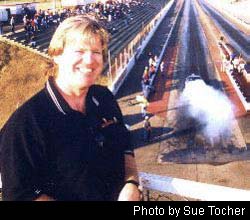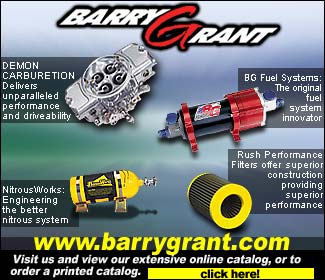
Beware of Late Arrivals
12/8/05

 utlaw
10.5 is one of the hottest segments in drag racing, and
for now at least, the Atlanta-based Outlaw Racing Street
Car Association (ORSCA) is at the forefront of the movement.
That’s why as a leader it has to be cautious in its
growth of the class.
utlaw
10.5 is one of the hottest segments in drag racing, and
for now at least, the Atlanta-based Outlaw Racing Street
Car Association (ORSCA) is at the forefront of the movement.
That’s why as a leader it has to be cautious in its
growth of the class.
It caught my attention, along with many others,
when a few NOPI Drag Racing Association (NDRA) regulars
said they were planning to show up for ORSCA’s season
ender at Atlanta Dragway in late November. Apparently, a
move was afoot to pit some of the Pro Outlaw Rear-Wheel
Drive import cars from NDRA’s second-fastest class
against the best in ORSCA’s all-American Outlaw 10.5
program.
There’s no question of NDRA racers being
able to lay down some good numbers, with the current Pro
Outlaw RWD quarter-mile records held by Brent Rau at 6.97
seconds and 198.29 mph in his turbocharged Mitsubishi Eclipse.
Compare that to the polesitting 6.96 at 203.80 by Outlaw
10.5 star Steve Kirk at Orlando’s World Street Nationals
this year or the outstanding 6.86 at 209.85 by Tim Lynch
at Englishtown a couple of weeks later and Rau is really
not that far off. On paper at least, the import guys can
be competitive.
ADVERTISEMENT
 |
But
the NDRA gang was a complete no show at Atlanta, though
a large NOPI series rig did make the trip and secured a
prominent parking space. Now, a debate is raging on ORSCA’s
online message board about whether the Pro Outlaw imports
even have a place in ORSCA’s premier division. The
consensus seems to be—and rightfully, in my opinion,
though not necessarily for the same reasons—‘Sure,
let ‘em race—but don’t give ‘em
any rule breaks! None!’
Despite a few “ricer” and “fart
rocket” comments from the peanut gallery, the issue
is not at all the vehicles’ country of origin but
rather the weight and size of tire on which they race. Essentially,
NDRA rules call for Pro Outlaw RWD cars to weigh between
1,800 pounds and 3,000 pounds minimum, depending on their
engine size and number of power adders used. ORSCA stipulates
minimum weights of 2,800 pounds to 3,000 pounds (including
driver) for its Outlaw 10.5 cars, again depending on the
engine/power adder combination, with all clutch cars also
required to add 100 pounds. At least at the upper ends of
the scale there doesn’t appear much difference—though
all racers know that even a few pounds in the right place
can make the difference in a tight race.
The rub lies in NDRA having no tire width
limitation, with 15-inch wide slicks typical in the class.
Outlaw 10.5, on the other hand, is defined by tire width
(it’s in the name!), with the approximately 11.25-inch
10.5W tire (don’t ask) being the basis and reason
for its existence. Most, if not all, ORSCA 10-wide cars
have more than enough horsepower to get down the track—regardless
of engine size or type—the challenge lies in getting
that power to the track on the relatively narrow rubber.
But the NDRA argument seems to be: “We’re
running about the same times in the eighth right now (4.60s-4.70s),
so let’s run heads-up with our own combinations (weight
and tires) and see how it works.” That’s the
proverbial slippery slope for ORSCA, though, as it can’t
make allowances for NDRA competitors and not for other would-be
entrants (Billy Glidden ring a bell?).
